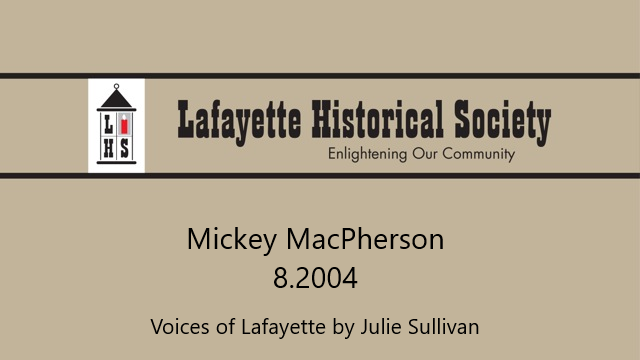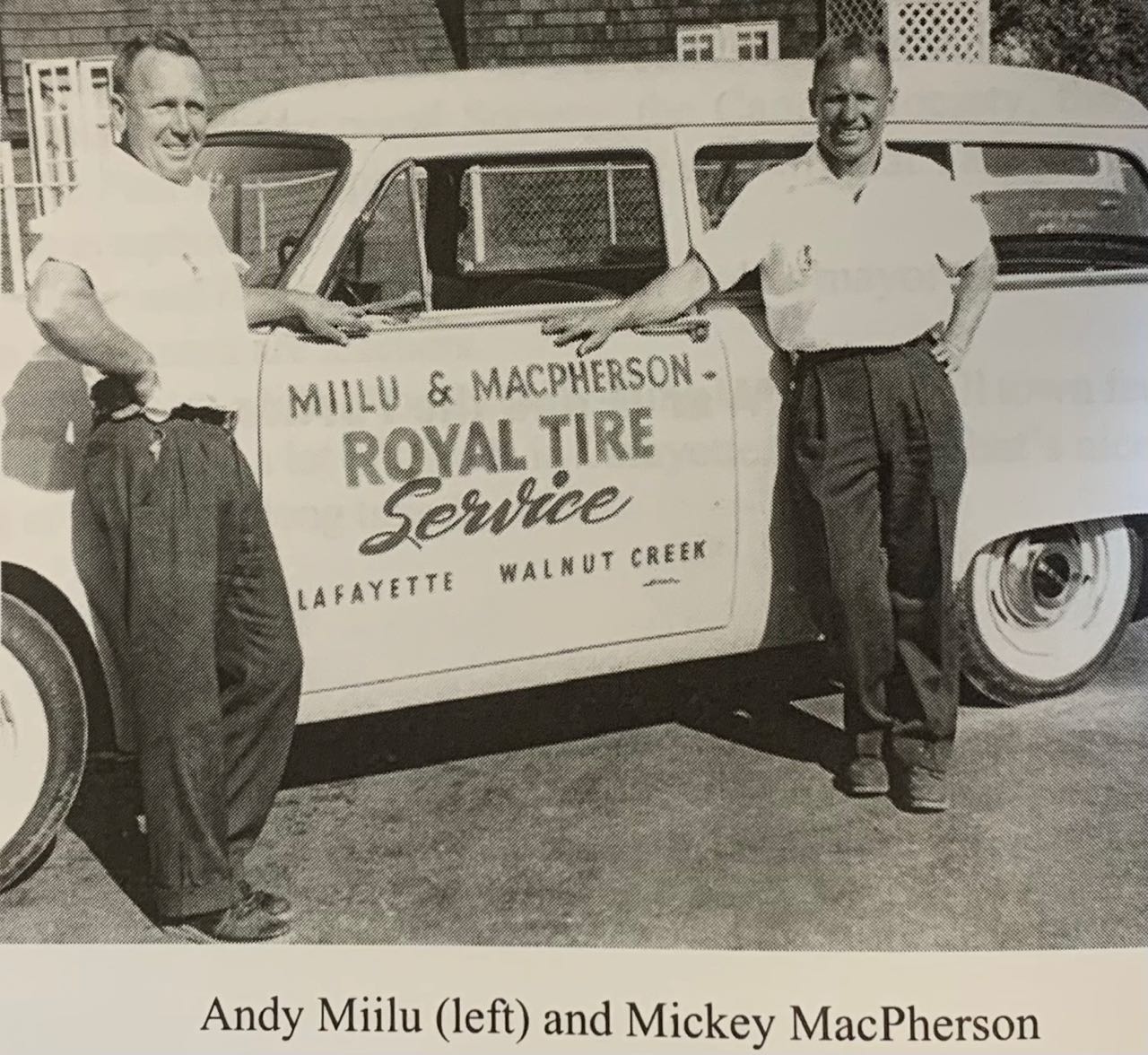Summary:
Mickey MacPherson was interviewed by Julie Sullivan in August, 2004. He was very industrious from a young age, hauling and delivering first coal, then gas and diesel to businesses and homes in Alameda County. In 1940 Mickey moved from Oakland to Lafayette where he and and his wife Helen built a house in Happy Valley and raised three children there. In 1944 he went into business with a partner, Andy Miilu, and for the next 40 years they built a company that eventually operated 10 service stations and two tire stores. He was still working at the time of this interview, at age 94.
Oral History:
Mickey MacPherson was born in 1910, and 94 years later he still hasn’t retired. He’s the elfish, gray-haired parking attendant at Longs Drugs on Mt. Diablo Boulevard. Christened Stanley at birth, he acquired his nickname in grammar school in Oakland. Before that, his Canadian- born father and his mother, who was born in Montana, lived in Nevada.
The second oldest of four brothers, he and his youngest brother, Joseph, 83, are the only surviving family members. “I was born in Rhyolite, Nevada, near Death Valley. It’s a ghost town now,” Mickey recalls. “My father hauled borax and ore for the mines through Death Valley in horse-drawn wagons. We’d travel about 100 miles altogether, to mining towns like Cain Wonder, Beatty and Chloride Cliff then back to Rhyolite.” In 1916, the family moved to Goldfield, Nevada, then in 1918 to Oakland.
“When I was a kid I used to hunt and fish in Lafayette,” he says. “You’d be surprised the fish we used to catch in these streams, and we’d hunt quail and deer and dove. It was open land, all farms and orchards. The area around Mt. Diablo Boulevard and Happy Valley Road was all pear and walnut orchards. I always loved it in Lafayette. I loved the country.”
Mickey and his wife, Helen, were married in 1937. They bought their first house in Oakland’s Glenview District. “Then we found Lafayette, where it was all open. That was just the ticket, because we wanted to raise kids. We took a ride one day and landed in upper Happy Valley,” he remembers. “We saw this acre lot that we loved and put a down payment on it. That was in 1940. We sold our house in Oakland and built the home we still live in.
“Lafayette was just a little farm town, a place where young people could get a nice house. All the people on our street were young.” The three MacPherson children, two boys and a girl, were born in Lafayette, graduated from Acalanes High School and went to college.
Mickey graduated from Oakland High. “I went to a lot of different high schools,” he adds. “They moved me, because I was a rascal. When I graduated, I thought I was doing well.”
Around 1924, Mickey’s father bought a coal yard, Lorin Feed & Fuel Yard, at 1718 Alcatraz Avenue, in south Berkeley. His father ran the business until he died in 1937, then his mother ran it after that. “My brother, Joe, and I sacked the coal in one hundred pound bags and made the deliveries,” Mickey explains. “The train tracks ran along Adeline Street, and they’d dump the gondolas next to the tracks. We would have six to eight gondolas at a time to unload and put in sacks. There were four coal yards in Berkeley. The coal came from Utah, Colorado, Wyoming, and even China.
“We had a Model A Ford and a Model T Ford truck, and what was called an Autocar truck. We started at 7:00 a.m. and finished when we were done. In winter it was a ten or twelve hour day. We delivered all through the Berkeley hills. We’d come home covered with soot, and the bath tub would be filthy when we were done.”
Delivering to homes involved carrying one hundred pound sacks of coal into the house and dumping them in the coal bin. Summer prices were a few dollars cheaper, sixteen dollars a ton. He remembers people in Piedmont getting two or three tons at a time, which could last several months for both cooking and heating.
“From 1940 until December 1944, I was the area salesman for Standard Oil Company in Richmond in charge of all the shipyards,” Mickey says proudly. “There were four Kaiser shipyards off Cutting Boulevard. I delivered gas and diesel. I still have my ID card issued by the Captain of the Port of San Francisco dated October 13, 1942.
“There was no five days a week back then! We worked all around the clock, a couple of weeks on graveyard, a couple on swing, and a couple on days. When we worked days, we got off at 4:00 p.m., then from four till eight we worked what they called the ‘Victory Shift,’ rolling barrels of aviation fuel into boxcars bound for the South Pacific.”
After the day shift was over, Mickey worked from 8:00 p.m. till midnight at Bacon Vulcanizing in Emeryville, where they made recap molds for tires. “It was all part of the war effort. Everything back then was, ‘Go, go, go!’ Working at the shipyards was the most interesting job anyone could ever want. At the four Kaiser yards, there were thousands of men and women from the whole country – the South, the Midwest – it was an education. And I saw a lot of ships being built.
“Number Three was the newest shipyard. They had what they called a coffer dam, about two hundred feet below ground level, where the ships were built. I’d sit in the tanker truck while a big crane picked it up and deposited it down in the dam. I’d fuel the tractors, compressors and cranes they used in shipbuilding right where they were working. I was the gas pump.”
Even though he loved his job with Standard Oil, when Mickey had a chance to go in business for himself, “I went!” he says emphatically. He and his partner, Andy Miilu, had worked together at a Standard Oil station in Oakland. They started with one service station in Oakland in December 1944. They opened a Lafayette tire store on Mt. Diablo Boulevard next to the former Butler-Conti Dodge in 1951. “I did mostly the tire work,” Mickey relates. “I was only somewhat a mechanic. I’d fill in on vacations. I worked six or seven days a week always. I loved it. Andy was a great salesman.
“Opening the Lafayette store was a terrific move monetarily. I knew most of my customers from Walnut Creek, and they followed us when we opened here,” he says. Mickey and Andy ran the business together until 1983, when they sold to Goodyear Tire Company. Andy passed away a few years afterwards. At the end, they had ten service stations in Orinda, Walnut Creek and Pleasant Hill and two tire stores, one in Walnut Creek and one in Lafayette.
“I stayed retired one week,” Mickey says, “then went to work for Chuck Stuart. I ran his Le Gas station at Mt. Diablo and Lafayette Circle.” Mickey left in 1999, when the station closed and went to work for Bill Eames as a parking lot attendant at Longs.
“The people motivate me to work. I love people. That’s why my job as a parking lot attendant is fantastic,” he explains. “I don’t get that many disagreeable people. It’s fun to get those people and make them realize the mistakes they’ve made.
“Today in Lafayette I miss the companionship of people. Lafayette used to be so small that you got to talk to them. The only ones you saw were the ones who lived here. You talked to them in the stores, or walking down the street. Everybody knew each other. During the war the women made bandages. There was a companionship that is lost, completely lost.”
He remembers “In Upper Happy Valley Frankie’s Place would have dances and barbecues.” He thinks traffic is the biggest change. “You used to see a car only every ten or fifteen minutes. There was no traffic.” He used to drive from his home down Mt. Diablo Boulevard to Walnut Creek in ten minutes.
“Things really started to change, I’d say, in the 1980’s. This place has grown fantastically in the last twenty years. But we can’t grow any more. We’re locked in, and I’m glad of it.”
Mickey’s memories of Lafayette in the early days include King’s Market where Safeway is now, and a restaurant called Bill’s next to King’s. “Where El Nido Motel was there was a little store, a white building that sold tobacco and soft drinks,” he adds. “I can’t remember the name. First it was a white goods store that sold stoves and refrigerators. Kelly Sporting goods came later. The Curve restaurant was built by Larry & Marge Sollars. That’s where the curve in the road is, on the right hand side. They had delicious food. There’s a Mexican restaurant there now. Later on, Don Thompson ran another restaurant near theirs. The others I remember on that end of town were Lorber, the veterinarian, Diamond K – Ogden Keisel built that – and up on the hill where the synagogue is now, there was a dog kennel. I think they raised Springers. I believe it later moved off Upper Happy Valley Road and may still be in operation today.
“Alsam was a night club where the old Cal Fed bank (now Citibank) was. Cunningham’s tire store came in. Angelo sold chickens in his butcher shop, and he was quite popular. There was the Seafood Grotto about a block down on the left side. They were very popular. They kept a crab pot outside in front of the place.
“Then there was Evans Ford, which is gone, and Kilbourn’s Kaiser and Frazier car dealer, also gone. Then Butler-Conti Dodge. And there were all the service stations: Standard, Union, Associated, Signal, and Seaside.”
Excerpted from “Voices of Lafayette” by Julie Sullivan. This book is available for purchase in the History Room.



Leave a Reply